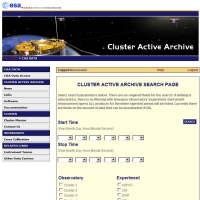The Cluster Active Archive Goes Online
1 February 2006
Today, 1 February 2006, exactly 5 years after the start of scientific operations on the four Cluster spacecraft, the Cluster Active Archive (CAA) goes online. CAA is the central depository of processed and validated high- and low-resolution Cluster data, raw data, processing software, calibration data, documentation and other value added products. CAA is a free system made available to the worldwide scientific community without any data right restrictions at http://caa.estec.esa.int.What is Cluster?
The Cluster and SOHO missions constitute the first cornerstone of ESA's Horizons 2000 Programme. Together they allow us to investigate the energy flow from the Sun to the Earth, and to study plasma processes in the Earth's magnetosphere driven by solar wind input, in unprecedented details.
Cluster is the first spacefleet composed of four spacecraft, flying in close formation, to study the magnetosphere. Each spacecraft is equipped with an identical set of 11 instruments to simultaneously measure essential physical parameters governing plasma dynamics, including the magnetic and electric fields (both DC and AC), the ion composition and the energy distributions of ions and electrons over a wide energy range. The four spacecraft are needed to provide a three-dimensional picture of physical processes governing plasma and to separate spatial and temporal features. Thanks to its unique four-point capability, Cluster is revolutionising our understanding of the dynamics of space plasmas. Data acquired by Cluster have led so far to more than 400 refereed publications in renowned scientific journals. A recent scientific discovery on magnetic reconnection, based on Cluster data, was used to illustrate the cover of Nature (12 January 2006 edition).
Originally funded to operate for two years, the Cluster spacecraft and payload continue to perform well and are expected to do so for several years to come. Cluster is now in an extended mission phase expected to last until December 2009.
Distribution of Cluster data
Today, 1 February 2006, Cluster is celebrating its 5th anniversary of scientific operations. Within five years, the total amount of data collected by the Cluster instruments and distributed by the European Space Operations Center (ESOC, Darmstadt, Germany) is of the order 1.4 Terabytes (more than 3000 CD-roms). An estimated amount of 250 000 CD-roms of raw data have been distributed by ESOC to scientists over the past 5 years. On 1 January 2006, the production of the Cluster CD-roms ceased, and from now on all Cluster raw data are accessible only over the internet through the Cluster Active Archive (CAA).
So far, the processed and validated high-resolution Cluster data were only accessible via the different Principal Investigators (PIs) and Co-Investigators (Co-Is) laboratories, in charge of the different Cluster experiments. On 25-26 February 2003, the Science Programme Committee (SPC) of ESA approved a new approach to access and archive the Cluster data, via the funding of the CAA (Image 1).
What is CAA?
 |
|
Image 1: Screenshot of the Cluster Active Archive website (http://caa.estec.esa.int/) [ESA] |
The CAA project team and system are located at the European Space research and TEchnology Center (ESTEC, Noordwijk, The Netherlands) of the European Space Agency. In view of the shortage of manpower in most PI institutes, ESA is supporting manpower deployed in institutes where the relevant expertise exists, to assist in the preparation, validation, and documentation of the high-resolution data deposited in the archive.
Opening of CAA
The CAA system has been available for registration and beta testing from 26 September 2005. The purpose of the testing period was to develop the system to a state where it is ready to serve the science community. Now from 1 February 2006 we invite the community to work on Cluster observations through the CAA.
During the past six months, the database of the high-resolution calibrated data products has been rapidly growing. Different instruments are at different phases mainly due to somewhat different starting times of their project but also due to different levels of difficulties encountered by them in the calibration processes of high-resolution data.
Although the system is now open to the world-wide user community, one should notice that the CAA is an active archive where the data products will improve in time and general caveats of the beta testing phase are still valid:
- There is a limit of 1 Gbyte on the amount of data that can be downloaded at one time
- All data retrieved should be treated with caution and users may wish to consult instrument experts before using the data for scientific analyses.
What next?
"The database will grow fast in the coming months. By 1 May 2006, all instruments should have produced two years worth of data into the CAA. Later this year the user interface will be updated so that users may also be able to see quicklook plots of their data requests; currently the data can only be downloaded with no visualization tools available. Also new data products will be ingested into the system", underlined Dr. Harri Laakso, ESA project manager of CAA at ESTEC.
The CAA will be active until year 2010 in a sense that it will be populated with new data as soon as the data products have been validated by the PI teams. Also, feedback from the users will be incorporated in the archive datasets.
If questions occur, please contact the CAA team at ESTEC by e-mail: caateam rssd.esa.int
rssd.esa.int
You can also provide feedback via the technical forum at http://www.cluster.rl.ac.uk/caa-bin/yabb/YaBB.pl/, linked from the right hand side navigation.
Web story authors
Arnaud Masson, Harri Laakso and C. Philippe Escoubet,
SCI-SH division, RSSD, ESA, The Netherlands
Tel: +31-71-565-5634

